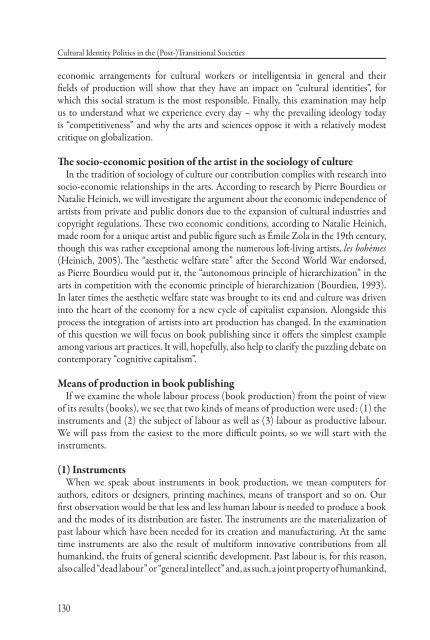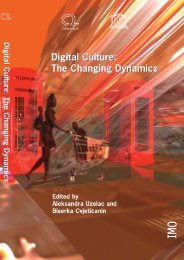free download in pdf format - Culturelink Network
free download in pdf format - Culturelink Network
free download in pdf format - Culturelink Network
You also want an ePaper? Increase the reach of your titles
YUMPU automatically turns print PDFs into web optimized ePapers that Google loves.
Cultural Identity Politics <strong>in</strong> the (Post-)Transitional Societies<br />
economic arrangements for cultural workers or <strong>in</strong>telligentsia <strong>in</strong> general and their<br />
fi elds of production will show that they have an impact on “cultural identities”, for<br />
which this social stratum is the most responsible. F<strong>in</strong>ally, this exam<strong>in</strong>ation may help<br />
us to understand what we experience every day – why the prevail<strong>in</strong>g ideology today<br />
is “competitiveness” and why the arts and sciences oppose it with a relatively modest<br />
critique on globalization.<br />
Th e socio-economic position of the artist <strong>in</strong> the sociology of culture<br />
In the tradition of sociology of culture our contribution complies with research <strong>in</strong>to<br />
socio-economic relationships <strong>in</strong> the arts. Accord<strong>in</strong>g to research by Pierre Bourdieu or<br />
Natalie He<strong>in</strong>ich, we will <strong>in</strong>vestigate the argument about the economic <strong>in</strong>dependence of<br />
artists from private and public donors due to the expansion of cultural <strong>in</strong>dustries and<br />
copyright regulations. Th ese two economic conditions, accord<strong>in</strong>g to Natalie He<strong>in</strong>ich,<br />
made room for a unique artist and public fi gure such as Émile Zola <strong>in</strong> the 19th century,<br />
though this was rather exceptional among the numerous loft -liv<strong>in</strong>g artists, les bohèmes<br />
(He<strong>in</strong>ich, 2005). Th e “aesthetic welfare state” aft er the Second World War endorsed,<br />
as Pierre Bourdieu would put it, the “autonomous pr<strong>in</strong>ciple of hierarchization” <strong>in</strong> the<br />
arts <strong>in</strong> competition with the economic pr<strong>in</strong>ciple of hierarchization (Bourdieu, 1993).<br />
In later times the aesthetic welfare state was brought to its end and culture was driven<br />
<strong>in</strong>to the heart of the economy for a new cycle of capitalist expansion. Alongside this<br />
process the <strong>in</strong>tegration of artists <strong>in</strong>to art production has changed. In the exam<strong>in</strong>ation<br />
of this question we will focus on book publish<strong>in</strong>g s<strong>in</strong>ce it off ers the simplest example<br />
among various art practices. It will, hopefully, also help to clarify the puzzl<strong>in</strong>g debate on<br />
contemporary “cognitive capitalism”.<br />
Means of production <strong>in</strong> book publish<strong>in</strong>g<br />
If we exam<strong>in</strong>e the whole labour process (book production) from the po<strong>in</strong>t of view<br />
of its results (books), we see that two k<strong>in</strong>ds of means of production were used: (1) the<br />
<strong>in</strong>struments and (2) the subject of labour as well as (3) labour as productive labour.<br />
We will pass from the easiest to the more diffi cult po<strong>in</strong>ts, so we will start with the<br />
<strong>in</strong>struments.<br />
(1) Instruments<br />
When we speak about <strong>in</strong>struments <strong>in</strong> book production, we mean computers for<br />
authors, editors or designers, pr<strong>in</strong>t<strong>in</strong>g mach<strong>in</strong>es, means of transport and so on. Our<br />
fi rst observation would be that less and less human labour is needed to produce a book<br />
and the modes of its distribution are faster. Th e <strong>in</strong>struments are the materialization of<br />
past labour which have been needed for its creation and manufactur<strong>in</strong>g. At the same<br />
time <strong>in</strong>struments are also the result of multiform <strong>in</strong>novative contributions from all<br />
humank<strong>in</strong>d, the fruits of general scientifi c development. Past labour is, for this reason,<br />
also called “dead labour” or “general <strong>in</strong>tellect” and, as such, a jo<strong>in</strong>t property of humank<strong>in</strong>d,<br />
130



